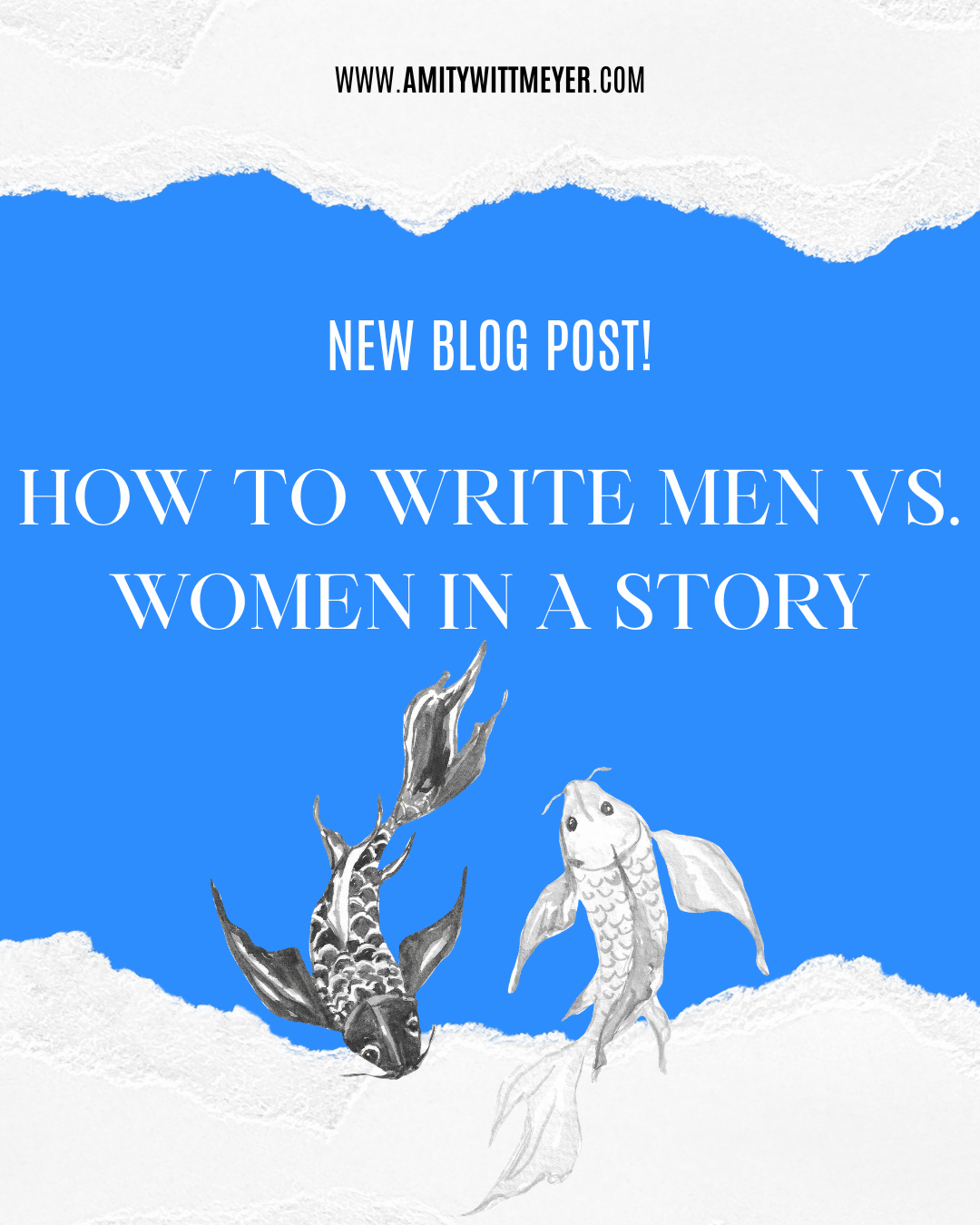Disclaimer: This post may contain affiliate links, which means we may receive a commission at no cost to you if you make a purchase through a link below.
Intro
We don’t understand each other. Men and women are opposites, and we need to understand each other’s strengths and weaknesses to work better together. And for YOU, as a writer, to create more in-depth and accurate characters.
“Men are from Mars. Women are from Venus.”
We all have heard this popular phrase growing up. I like this one better:
“Snips, snails, and puppy dog’s tails, that’s what boys are made of. Sugar and spice and everything nice, that’s what girls are made of.”
Ultimately, women and men are different, and sometimes it seems we don’t even speak the same language. It’s almost like we’re two separate species. Well, we are, neurologically speaking. By the end of this blog post, you’ll have a better understanding of how to write male vs. female characters in your next story.
Psych 101 DOESN’T Cut It
For starters, I recently got very interested in psychology, particularly what I wasn’t being taught in my college class. I started to run through the test that has become a subconscious question whenever new information is learned: Is it different for women?
Normally, with most human-related sciences, men are the most studied and tested as the default. It’s unfair! I decided to educate myself on the differences between the male mind and the female mind for cis heterosexuals.
Recommendations:
I read Brain Sex: The Real Difference Between Men and Women and was blown away! I highly encourage every human being to read this book to gain a deeper understanding of why men and women often don’t see eye-to-eye. How could we? We are wired to think different things are important and act accordingly.
In summary, when you are writing a story, research, research, research. Whether it’s for a historical fiction novel, a story set in a different location or time, your reader will fall out of the world you created just because certain elements are inaccurate or don’t make sense.
The same goes for character development.
The Bechdel Test
Therefore, when writing your next novel and formulating a character list, ask yourself how many men vs. how many women are in this story? Normally, the problem is that you don’t have enough female characters to pass what is widely known in the world of writing: the Bechdel test. Your story can only pass this test if it
-
- a) has more than one female character
-
- b) the women have a conversation about something other than men
Sounds easy? You’ll be surprised how many movies and books there are where the writers have failed this test (when I say writers, more often than not, they are male. Do not be another addition to this list!). Remember reading The Great Gatsby for school? Yes, this book has a big fat F for failing the Bechdel test!
Recommendations:
Here are some examples of books that do pass the test. I recommend checking them out to further understand what well-written characters are.
-
- A Handmaid’s Tale by Margaret Atwood, Matilda by Roald Dahl
- Jane Eyre by Charlotte Brontë
- Anne of Green Gables by L.M. Montgomery
- The Bell Jar by Sylvia Plath
- The Secret Garden by Frances Burnett
- The Hunger Games by Suzanne Collins.
Why is this important?
You will lose credibility with your reader if you are unable to show that women can hold a topic of conversation around something other than men. The female characters will look thrown together and one-note if you fail this test. It simply isn’t realistic.
Now for the nitty-gritty of psychology.
Sex Differences in the Brain
Important note: this information relates to cis, heterosexual men and women. Variations in sex and gender have proven changes in the brain’s structure, and I will discuss those in a later post.
In summary, men are better at spatial awareness, problem-solving, and seeing the world as made up of tools/objects to understand and use. Women are more sensual, seeing the world through relationships.
According to neurological researchers Xin, Zhang, Tang, and Yang in their study in 2019, “Brain Differences Between Men and Women: Evidence From Deep Learning,” they produced a 3D PCNN algorithm to map out each sex’s brain structure.
A PCNN is a neural network visualization that shows how neurons in the visual cortex process information.
In their findings, they confirmed many differences. One major conclusion is that men have more grey matter, composed of active neurons.
Grey matter is the darker tissue in your brain and spinal cord that shapes day-to-day function. The study proves that the male mind has strength in action, and its function relates to physical behavior.
Women have more white matter for neuronal communication.
White matter is the area related to the central nervous system that affects learning and coordinated communication between the brain regions. The study proves that the female brain has strength in assessing, making deeper cognitive connections, and its function relates to verbal behavior.
Therefore,
-
- Women are better communicators
-
- Men are better problem solvers
To remember, think about caveman times. Men needed to focus on themselves in order to fight off other males and reproduce. Women needed to be more aware of others’ intentions to remain safe and pay more attention to care for their children’s health and wellbeing.
The Male Brain
Bluntly speaking, Men are inherently self-focused creatures. Ultimately, their brains are wired to make them meet their own needs before others. In consequence, they are worse at multitasking, understanding nonverbal social cues, and remembering faces and names.
Again, they are programmed to take an interest in objects/tools. So, they see the world as full of various things they wish to understand and master. They are designed to want to dominate or rise in power.
Men have fewer connections across the brain regions, making them struggle to express their emotions and take a more logical route to their reactions.
Men hear and feel less. They are less likely to notice distractions and are single-minded, using all their effort to focus on one problem at a time. Men solve issues in a logical, practical, and inherently self-focused manner. Male relationships are centered around the need for dominance or power.
Summary
To conclude, men will value the need to rise up in power or problem solve, typically following jobs that have a hierarchy of power, and are more object-focused (like the accumulation of money).
Typical jobs include inventors, mechanics, and tech-related jobs. Ever wonder why male veterans are so proud of their past position? Hopefully, it’s all starting to make sense now.
The Female Brain
Moving on to women. In summary, women are relationship-driven. They have better verbal dexterity than men. The two sides of the brain, connected by the corpus callosum, have more connections for women, proving their verbal dexterity and ability to more easily verbalize their emotions. In consequence, women may have trouble separating logical reasoning from emotional feelings from time to time.
Women are better at handling pain. Also, they are more sensitive to touch, taste, smell, sight, and sound. Since women are more relationship-driven, they will attach more importance to personal and interpersonal aspects in their lives.
Ultimately, Women are better at understanding and expressing nonverbal social cues in body language. They are also better at remembering faces and voices.
Summary
In summary, women are more intuitive. Their relationships are driven by the desire to complement, associate, and interplay. Women are more likely to become teachers, artists, nurses, and other professionals who value human connection and communication.
Scientific Conclusion
Overall, men are more self-focused and view the world more logically. On the other hand, women are more relationship-focused and value connection over a rise in status.
So when writing a female character, you need to remember how they are programmed: emphatic and relationship-driven. Whereas for men, they are object-oriented and focused on a rise in power for themselves.
To conclude, don’t fail the Bechdel test and think that you aren’t missing anything by forgetting to add some extra female characters. Remember that writing men and women should feel very separate if you want to do it correctly.
Takeaway For Writing
Wrapping things up, ever wondered why the classic hero’s journey story has a male protagonist? Or stories about family, community, or social norms usually have a female protagonist? In actuality, it’s not just a coincidence, but more true to the predetermined way our brains value different things.
So, if you’re struggling to write male characters, think first of the basic neurological framework of their brain and determine what their need is vs. what they want for your story. As for women, notice how complex their brains are in comparison. Female characters should be extremely complex as a result, not one-note or continuously centering men around their every move.
Start Writing
Female characters should be better at reading the room, noticing others’ emotions, and being adaptive to remain safe. Men should behave more logically, perhaps occasionally misunderstanding others’ true intentions or struggling to verbalize their own emotions, and centering themselves first.




